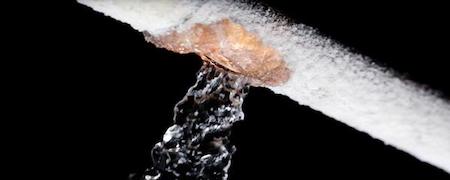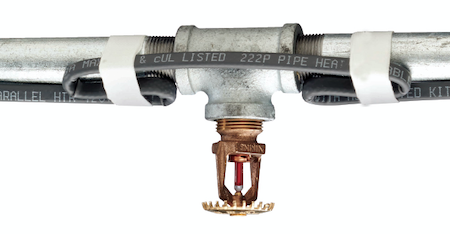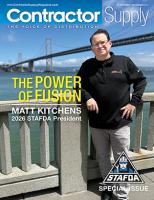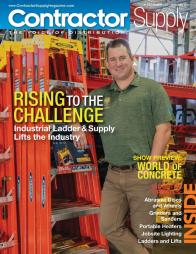Exclusive: Warning Signs that Your Pipes are Frozen… and Simple Ways to Prevent It
Don’t let a cold snap put your house or business under water.
 |
 |
 |
Consider this: a gallon of water, when frozen, will expand to a volume 9% greater than its original size. So it is no surprise that a frozen pipe will swell up and crack, leaving building owners faced with costly flood damage.
Unheated areas pose the greatest risk for frozen pipes like the basement, attic, garage, or crawl spaces. Pipes that run along exterior walls with insufficient or no insulation are also at risk for freezing in winter months. The fact is, any pipe exposed to temperatures below 20°F for several hours at a stretch runs the risk of freezing.
Unfortunately, once ice inside a frozen pipe begins to melt and water seeps out, it is already too late. A crack as small as 1/8-inch in a pipe can spray more than 250 gallons of water a day — ruining floors, carpets, furniture and irreplaceable personal belongings.
Compounding the problem is that pipes can break in more than one place. Depending on the extent of the damage, total cleanup costs from a single busted pipe can soar to tens of thousands of dollars. State Farm Insurance estimates the average insurance claim for water damage from frozen pipes is approximately $10,000. Homeowner's insurance might not cover the cost of repairing a burst pipe, but may pay for any resulting water damage, depending on the terms of the policy.
Signs of Frozen Pipes
If a pipe is frozen, there's approximately a 50% chance it cracked. A bulge or crack in a pipe with ice seeping out is a clear indication of a burst pipe. Frost on the outside of a pipe is another likely sign that it’s already frozen. Occasionally, however, the pipe may look fine and a homeowner may not see the small fractures caused by ice expansion.
A less obvious warning sign is a nasty smell from the drain or faucet. This is because odors can’t filter out of a frozen pipe, and instead are forced to come back up towards the home. Or if you turn on a faucet but no water or only a few drips come out then it’s likely that the pipe is frozen. Whistling and banging coming from pipes, or strange bubbling sounds when you flush a toilet, are also bad news. Finally, take a look at the drywall and ceilings. If you notice dampness, puddles, or rings, there’s a serious issue.
If you know what to watch out for, you’ll be able to act much faster — potentially preventing a serious disaster. Pipes that have already frozen but haven’t burst require a professional’s help as soon as possible.
Now that you know much more about the basics of frozen pipes, let’s talk about what you can do to stop them from freezing in the first place.
Heating Cables
The best preventative solution is to install electric heating cables on your pipes. When combined with an integrated thermostat, this type of system automatically turns “on” when temperatures drop below freezing. Heating cables provide the needed level of warmth to keep pipes from freezing but not enough to heat the water inside of the pipes. And because the thermostat automatically controls the system, it saves energy by powering on the cable only when required.
For optimal performance of the system, pipe sleeves can be installed over the cable to help retain heat, and plastic pipes can be wrapped in aluminum foil so the heat is dissipated evenly in the pipe. The benefit of this design is that the cables are installed once and left mounted on pipes for years — even when temperatures drop as low as -40°F (-40°C).
Basic Maintenance
You can prevent frozen pipes with some simple, inexpensive steps. For one, as long as the water's flowing through the pipes, even at just a trickle, there's less chance of it forming into ice, so let water drip from the faucets served by exposed pipes. Plumbers recommend running water from both the hot and cold taps if you can.
Next, keep your thermostat set to the same temperature and never below 55° F. While it may be tempting to continually adjust the thermostat as temperatures fluctuate, a constant circulation of warm air will prevent a costly plumbing repair. While you may incur a higher heating bill, you can prevent a much more pricey repair job if pipes freeze and burst.
As a last preventive measure, leave cabinet doors open and use a fan to circulate warmer air if kitchen or bathroom pipes are near exterior walls. It is also a good idea to drain and disconnect garden hoses before cold weather arrives.
Sleeves and Seals
For next-level protection, seal cracks, holes, windows, doors and other openings on the exterior walls with quality sealant, caulk or insulation to prevent arctic cold air from penetrating the wall cavity. On the interior, insulate and seal attic penetrations such as partition walls, vents, plumbing stacks, and electric and mechanical chases. Another tried and true safeguard are pipe sleeves, especially for pipes that run through the attic or crawl space. Be sure to set the foam pieces tight against each other and seal the slits and joints with duct tape. Exterior faucets should also be insulated with foam faucet covers. If you’re a bit anxious about fitting insulation on your own, call in a professional to help.
Don’t Get Frozen Out
In Northern parts of the United States that experience freezing temperatures, walls are built thicker and with more insulation. Pipes may be several feet underground or run up through a basement to protect them. In southern areas, however, pipes are only weatherized to handle the challenges of extreme summer heat, and are more likely to be installed on exterior walls or in attics. When a sudden cold snap moves in, as it did in Texas last winter, the results are disastrous.
The cold truth is that no matter where you live, you need to recognize and be ready for the dangers of frozen pipes. Simple preventive measures, along with installing pipe sleeves and heating cables, can save tens of thousands of dollars in repairs.
Learn more at www.easyheat.com
About Emerson
Emerson (NYSE: EMR), headquartered in St. Louis, Missouri (USA), is a global technology and engineering company providing innovative solutions for customers in industrial, commercial, and residential markets. Our Emerson Automation Solutions business helps process, hybrid, and discrete manufacturers maximize production, protect personnel and the environment while optimizing their energy and operating costs.
Our Emerson Commercial & Residential Solutions business helps ensure human comfort and health, protect food quality and safety, advance energy efficiency, and create sustainable infrastructure.
For more information visit www.Emerson.com.
















